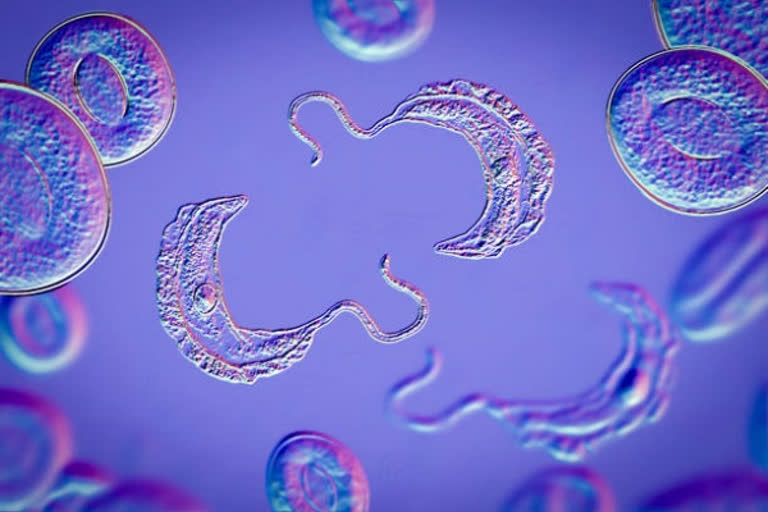Hyderabad: Trypanosoma cruzi (T. cruzi) infection is endemic in Latin America. T. cruzi can be transmitted to human beings through the feces of a kissing bug, congenitally, blood transfusion, oral transmission, laboratory contamination, and organ transplantation. In 14–30% of patients, acute T. cruzi infection is followed by a long, clinically silent period before the clinical presentation of chronic Chagas’ disease (CD).
The T. cruzi infection may result in heterogeneous heart (H) phenotypes, including bradycardia; right bundle-branch block, left anterior fascicular block; cardiomyopathy; heart failure (HF), thromboembolism; arrhythmias; sudden death; and syncope. The prognosis of HCD patients is worse compared with the prognosis of other etiologies of HF.
Pharmacological, non-pharmacological, and antiarrhythmic therapy for HCD is mostly based on reported results for other etiologies. Trials for specific treatment for T. cruzi infection in CD have had neutral results. Of particular concern is the spread of T. cruzi among infected migrants throughout the world causing a dramatic increase in the number of cases in non-endemic countries, turning the disease into a worldwide public health concern. It is estimated that 400 000 infected persons live in non-endemic countries.
T. cruzi-infected patients can potentially spread the infection via blood transfusion, organ transplantation, and mother-to-child transmission. In non-endemic countries delays in CD diagnosis influenced by the asymptomatic intermediate phase, and the lack of awareness and physicians sufficiently trained to diagnose asymptomatic and symptomatic CD might result in missed diagnostic and treatment opportunities. Likewise, addressing diagnosis of CD around the world is relevant. In this issue of The Lancet Regional Health − Western Pacific, Rodríguez et al. reported in a cross-sectional study including 428 migrants living in Japan from March 2019 to October 2020, a prevalence of 1·6% of T. cruzi infection.
Most of the migrants were from Brazil, Bolivia, and Peru. Bolivians had a seropositivity prevalence of 5·3%. The screening model was reported as more cost-effective than the non-screening model from a health care perspective (ICER=200,320 JPY, approximately 1500 US dollars). The authors raised the question of whether the screening should be offered to all Latin American migrants or only to those from Bolivia. If the adjusted prevalence (0·12%) represents the real situation, the screening would be cost-effective only for Bolivians. Therefore, the authors proposed that Bolivian citizens should be prioritized, and the official recommendation should cover all people at risk for CD, as recommended by the World Health Organization.
Also read: Elderly have double the risk of Alzheimer's disease even after a year of Covid-19: research
In line with this, an epidemiological study in Japan found that the prevalence of CD was 0·017% among 18 076 blood donors who were at risk for CD. Also, in Japan 17 patients with CD were previously reported, 11 (64.7%) of whom were immigrants from Latin America. One case was a Japanese individual who had a congenital infection. CD prevalence of 4·2% was reported among Latin-American migrants in Europe. In concordance, screening for CD in asymptomatic Latin American adults living in Europe was reported to be a cost-effective strategy.
A congenital CD screening program in the United States was cost saving for all rates of congenital transmission more than 0·001% and all levels of maternal prevalence greater than 0·06%. However, the Rodríguez et al. results should be interpreted cautiously.
The merit should be tempered by uncertainties that might result from treatment choice. For cost-effectiveness analysis, the authors assumed that the treatment might be effective for reducing CD events. However, the efficacy of the available drugs benznidazole and nifurtimox is low for chronic CD, the phase in which most patients are diagnosed. Otherwise, cost-effectiveness studies in general were based on an estimated treatment efficacy of at least 20%.
The advantage of CD screening might be to permit specific treatment to be offered to people <18 years of age, to babies born to infected mothers, screening of donors before transplant patients receive organs-blood from infected individuals, avoid risk by blood transfusion, early diagnosis of T. cruzi infection reactivation, and management of CD cardiomyopathy.
The next steps and challenges would be to introduce widespread active programs for all non-endemic regions to enable early diagnosis and treatment strategies for CD for high-risk populations. Also, training doctors who treat patients with CD, new research in CD in non-endemic areas, and development of new trypanocidal strategies are warranted. This may be the way to try to overcome CD, the hidden enemy around the world.



